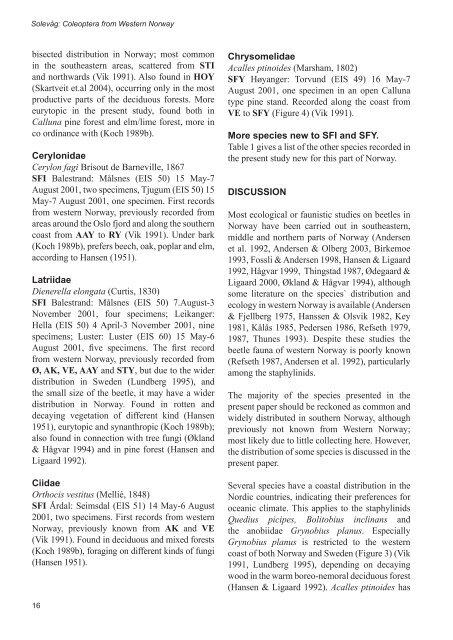Norwegian Journal of Entomology - Norsk entomologisk forening
Norwegian Journal of Entomology - Norsk entomologisk forening
Norwegian Journal of Entomology - Norsk entomologisk forening
You also want an ePaper? Increase the reach of your titles
YUMPU automatically turns print PDFs into web optimized ePapers that Google loves.
Solevåg: Coleoptera from Western Norway<br />
bisected distribution in Norway; most common<br />
in the southeastern areas, scattered from STI<br />
and northwards (Vik 1991). Also found in HOY<br />
(Skartveit et.al 2004), occurring only in the most<br />
productive parts <strong>of</strong> the deciduous forests. More<br />
eurytopic in the present study, found both in<br />
Calluna pine forest and elm/lime forest, more in<br />
co ordinance with (Koch 1989b).<br />
Cerylonidae<br />
Cerylon fagi Brisout de Barneville, 1867<br />
SFI Balestrand: Målsnes (EIS 50) 15 May-7<br />
August 2001, two specimens, Tjugum (EIS 50) 15<br />
May-7 August 2001, one specimen. First records<br />
from western Norway, previously recorded from<br />
areas around the Oslo fjord and along the southern<br />
coast from AAY to RY (Vik 1991). Under bark<br />
(Koch 1989b), prefers beech, oak, poplar and elm,<br />
according to Hansen (1951).<br />
Latriidae<br />
Dienerella elongata (Curtis, 1830)<br />
SFI Balestrand: Målsnes (EIS 50) 7.August-3<br />
November 2001, four specimens; Leikanger:<br />
Hella (EIS 50) 4 April-3 November 2001, nine<br />
specimens; Luster: Luster (EIS 60) 15 May-6<br />
August 2001, five specimens. The first record<br />
from western Norway, previously recorded from<br />
Ø, AK, VE, AAY and STY, but due to the wider<br />
distribution in Sweden (Lundberg 1995), and<br />
the small size <strong>of</strong> the beetle, it may have a wider<br />
distribution in Norway. Found in rotten and<br />
decaying vegetation <strong>of</strong> different kind (Hansen<br />
1951), eurytopic and synanthropic (Koch 1989b);<br />
also found in connection with tree fungi (Økland<br />
& Hågvar 1994) and in pine forest (Hansen and<br />
Ligaard 1992).<br />
Ciidae<br />
Orthocis vestitus (Mellié, 1848)<br />
SFI Årdal: Seimsdal (EIS 51) 14 May-6 August<br />
2001, two specimens. First records from western<br />
Norway, previously known from AK and VE<br />
(Vik 1991). Found in deciduous and mixed forests<br />
(Koch 1989b), foraging on different kinds <strong>of</strong> fungi<br />
(Hansen 1951).<br />
16<br />
Chrysomelidae<br />
Acalles ptinoides (Marsham, 1802)<br />
SFY Høyanger: Torvund (EIS 49) 16 May-7<br />
August 2001, one specimen in an open Calluna<br />
type pine stand. Recorded along the coast from<br />
VE to SFY (Figure 4) (Vik 1991).<br />
More species new to SFI and SFY.<br />
Table 1 gives a list <strong>of</strong> the other species recorded in<br />
the present study new for this part <strong>of</strong> Norway.<br />
DISCUSSION<br />
Most ecological or faunistic studies on beetles in<br />
Norway have been carried out in southeastern,<br />
middle and northern parts <strong>of</strong> Norway (Andersen<br />
et al. 1992, Andersen & Olberg 2003, Birkemoe<br />
1993, Fossli & Andersen 1998, Hansen & Ligaard<br />
1992, Hågvar 1999, Thingstad 1987, Ødegaard &<br />
Ligaard 2000, Økland & Hågvar 1994), although<br />
some literature on the species` distribution and<br />
ecology in western Norway is available (Andersen<br />
& Fjellberg 1975, Hanssen & Olsvik 1982, Key<br />
1981, Kålås 1985, Pedersen 1986, Refseth 1979,<br />
1987, Thunes 1993). Despite these studies the<br />
beetle fauna <strong>of</strong> western Norway is poorly known<br />
(Refseth 1987, Andersen et al. 1992), particularly<br />
among the staphylinids.<br />
The majority <strong>of</strong> the species presented in the<br />
present paper should be reckoned as common and<br />
widely distributed in southern Norway, although<br />
previously not known from Western Norway;<br />
most likely due to little collecting here. However,<br />
the distribution <strong>of</strong> some species is discussed in the<br />
present paper.<br />
Several species have a coastal distribution in the<br />
Nordic countries, indicating their preferences for<br />
oceanic climate. This applies to the staphylinids<br />
Quedius picipes, Bolitobius inclinans and<br />
the anobiidae Grynobius planus. Especially<br />
Grynobius planus is restricted to the western<br />
coast <strong>of</strong> both Norway and Sweden (Figure 3) (Vik<br />
1991, Lundberg 1995), depending on decaying<br />
wood in the warm boreo-nemoral deciduous forest<br />
(Hansen & Ligaard 1992). Acalles ptinoides has

















